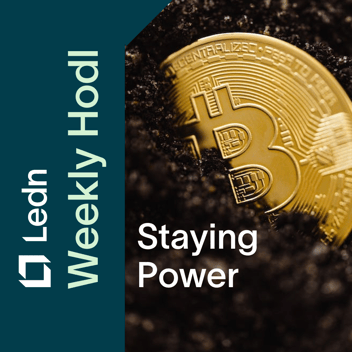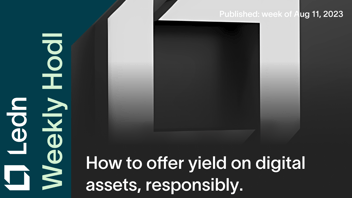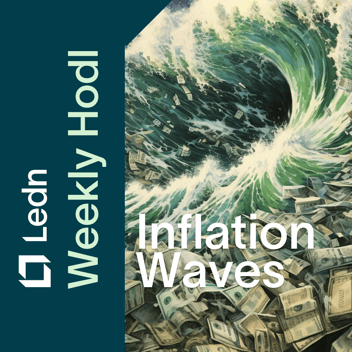Weekly Hodl: Expect the unexpected
.png?width=1280&height=720&name=YT%20English%20(4).png)
Ledn’s Weekly Hodl: Expect the unexpected
Week of Monday July 3rd, 2023
Start earning up to 9% APY on your crypto with a Ledn Savings Account.
July Open Book Report Now Available
Ledn's monthly Open Book Reports outline the current utilization of USDC and BTC assets, so that our clients can better understand how we generate interest for our yield products and how we offer lower loan rates. See the report.
Bitcoin Market Analysis
Bitcoin closed last week up +0.44% at $30,613 on relatively high trading volume. So far this week, it has continued to hold above $30k - currently trading at $30,455.
The wildest swings came last Friday, when Bitcoin traded from a low of around $29,400 to a high of $31,200 before settling at $30,400. The volatility was due to the news that the SEC had asked the bitcoin spot ETF applicants to “re-file” their applications with additional information. By the end of Friday, Nasdaq had not posted the updated Blackrock application-, which led some investors to believe that Blackrock would not proceed with its application. The fears were quickly calmed on Monday when Nasdaq updated its website to show that Blackrock had re-filled immediately on Friday but the site had not been updated. In very short order, all of the ETF applicants revised their submissions as requested by the SEC. Prices have held steady since then.
In terms of near-term catalysts, Bloomberg ETF Analyst Eric Balchunas wrote today that the SEC is rumored to have asked all Bitcoin ETF applicants to meet next week.
If the SEC indeed asked all Bitcoin ETF applicants for a meeting next week, the outcome of that meeting could produce a major catalyst for bitcoin price in either direction.
In terms of technical support and resistance levels, we continue to monitor the $30k level as key support. Beneath that, we are monitoring the 200-week moving average price as the next key support level at $26,822. In terms of resistance, the next key level for bitcoin to overcome will be the $35k level.
Our Weekly Essay: Expect the unexpected
Humans learn - that’s how our civilizations have evolved. When winter was coming, we learned that we needed to store food reserves to survive. We learned the hard way that if we don’t build water reserves and a drought hits, people will suffer. Over time, we’ve learned to prepare for events that _might_ deliver a negative outcome, out of survival. When we are prepared for an event, the reaction can be orderly and suffering is minimized. When we are unprepared for an event, the opposite happens. In short, if everyone expects something to happen, and can prepare, any negative impact can be greatly mitigated. The same is true for markets. Big moves happen when no one is expecting them. In today’s essay we dive into the whys.
Human see, human do
Humans are social creatures - and we are also competitive. As such, many of our behaviours are influenced by what other people around us are doing and saying.
Take the Covid pandemic as an example. Leading up to February 17th, 2020 the S&P was up +13.56% over a 19-week period. The first COVID case in the U.S. was identified on January 20th, and by the end of January COVID was present in 26 countries. Still, the S&P 500 made a new all time high on the week of February 17th. You read that right - the S&P 500 made a new all-time high 4 weeks after the first COVID case was identified in the U.S., and despite the fact that COVID was present in more than 26 countries at the time.
Leading up to the COVID crash, markets were on “auto-pilot”. Nobody was even thinking about protection or insurance. The VIX volatility index, which measures implied volatility in the S&P 500 contracts - or the premium investors pay to protect their portfolios, was trading at 16.92 on the week of Feb 17th. As the market started crashing on the week of Feb 24th, the VIX soared to 66 over the following weeks as investors rushed to buy downside protection.
The market bottomed on the week of March 23rd, but investors kept paying up for downside protection, even as the market rallied and recovered.
By the time the S&P 500 made a full recovery to its pre-pandemic levels and reclaimed its all-time high, the VIX was trading at 22.
Even when the S&P 500 made its record all-time high in January 2022, the VIX remained at ~18. That’s still 6% higher than its pre-pandemic level.
In other words, the world knew that COVID was spreading - but because the market was doing so well leading up to the event, no one thought of purchasing insurance to the downside. When the bad news hit, there was no insurance, and people liquidated their stocks out of fear.
It’s the “unhedged” or “forced sellers/buyers” on the margins that create outsized moves in price. And there were a lot of people caught without hedges or insurance when COVID hit. That created a massive move to the downside, shedding -35% in the span of 4 weeks.
Recency Bias
Not surprisingly, as the market was crashing down between Feb 17th and March 23rd, investors got into very defensive positions to protect their portfolios. Once investors hedged their downside from further losses, markets started rallying.
The chart below tracks the S&P 500’s Put/Call ratio - that is, how many “put” or defensive options are open in the market, vs. how many “call” or offensive options are open in the market. Typically, a high Put/Call ratio means investors are hedging for downside protection - conversely, a low Put/Call ratio means that investors are looking for upside.
As you can see from the chart, the Put/Call ratio was dropping leading up to the COVID crash - and it caught a lot of people without insurance.
Conversely, you can see that after the crash, investors continued buying downside protection as the market rallied, and paying a premium for it. This is evidenced through an elevated put:call ratio which was sustained throughout 2021 until mid 2022. Similarly, the VIX remained elevated during that same period, ranging from 17 to 33.
Where are we now?
Fast forward until today, and you’ll notice that things look a lot more “normal”, on the surface.
The S&P is up +16% year to date, and nearly +25% since October 2022. It’s only 8% away from its all-time high.
The VIX is trading back within its pre-pandemic range. In fact, it is at its lowest level in 3 years.
The Put/Call ratio is also back to its pre-pandemic range. In other words, investors have let their guards down in terms of downside protection (even though insurance is much cheaper now).
According to markets, things are pretty much “back to normal”. The recent rally has made people feel more comfortable about jumping back into the markets. Moreover, any fund manager or investment advisor that has underperformed year-to-date now has an incentive to “make up the difference”, and is feeling pressure to chase the market higher. Gradually, it appears that “higher for longer” is becoming the consensus view - as we wrote several weeks ago.
However, if you look under the surface, the macroeconomic conditions are very different now vs. then.
And the main consideration boils down to this: Central Banks have raised interest rates dramatically. Leading up to COVID, the Fed took rates to 2.4% and things started breaking. It had to drop rates 3 times in 2019, and drop rates to 1.50%. In other words, the “terminal rate” that the market withstood back then was 2.40%. Today the rate has more than doubled, at 5%.
The impact of high interest rates in a credit-based economy cannot be understated. High interest rates do 2 things:
First, it depletes the purchasing power of any company or person that has debt, by making that debt much more expensive to service. This means less money to spend on everything else.
Second, high interest rates from the Fed compete with private investment. Every time the Fed raises what it can pay investors, every other borrower must do the same to compensate for the “risk premium” of not lending to the Fed. Eventually, this can reach a tipping point as we’ll explain below.
When the Fed raises interest rates, the earnings yield of private companies with debt will drop, and the interest that the Fed pays investors rises, this gradually makes both instruments more competitive in terms of yield. Eventually, if both instruments yield the same, but one has no risk, the decision is pretty simple for an investor.
If and when enough people wake up with this realization, they’ll start selling their stocks to buy government bonds. Layer this with the fact that investors have started letting their guards down in terms of downside protection, and that could cause markets to come under pressure.
Closing thoughts
As investors, we should always be skeptical of the consensus view. When everyone is waiting for something to happen to profit from it, it rarely ever happens.
For a prepared investor, markets under pressure could present great opportunities to benefit from better purchase prices for assets you want to hold long term (like bitcoin), and higher volatility means higher interest rates in products like Ledn’s Dual Cryptocurrency Notes, from which investors can also benefit.
Stay on your toes and be skeptical of investor “groupthink”.
Hodl.
Notice for Canadian Residents: As of January 4, 2023, Canadian clients will no longer be able to take out new B2X loans.
As of February 1, 2023, Canadian clients will no longer be able to open a new BTC or USDC Savings Account, deposit BTC or USDC to existing Savings Accounts or earn yield on any existing BTC or USDC Savings Account balances.
Notice for U.S. Residents: Effective March 1, 2023, U.S. clients will not earn interest on any BTC and/or USDC balance in their Savings Accounts and/or Legacy Savings Accounts.
This article is intended for general information, educational and discussion purposes only, it is not an offer, inducement or solicitation of any kind, and is not to be relied upon as constituting legal, financial, investment, tax or other professional advice. This article is not directed to, and the information contained herein is not intended for distribution to, or use by, any person or entity in any jurisdiction or country where such distribution, publication, availability or use would be contrary to law or regulation or prohibited by any reason whatsoever or that would subject Ledn and/or its affiliates to any registration or licensing requirement. This article is expressly not for distribution or dissemination in, and no Ledn product or service is being marketed or offered to residents of, the European Union, the United Kingdom, the United States of America or any jurisdiction in Canada, and such product or service may only be marketed or offered in such jurisdictions pursuant to applicable laws or reliance on regulatory exemptions. A professional advisor should be consulted regarding your specific situation. Digital assets are highly volatile and risky, are not legal tender, and are not backed by the government. The information contained in this publication has been obtained from sources that we believe to be reliable, however we do not represent or warrant that such information is accurate or complete. Past performance and forecasts are not a reliable indicator of future performance. Any opinions or estimates expressed herein are subject to change without notice. This article may contain views or opinions of the author that do not necessarily reflect the opinions, standards or policies of Ledn. We expressly disclaim all liability and all warranties of accuracy, completeness, merchantability or fitness for a particular purpose with respect to this article/communication. Read our Disclaimers at https://ledn.io/legal/disclaimers



